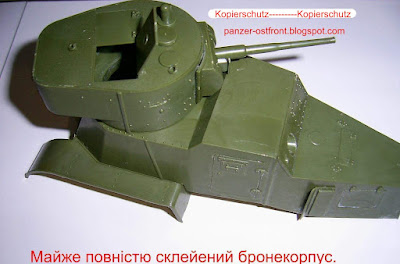Самохідна артилерійська установка Semovente da 75/18
М40.
У 1941 році на базі італійського командирського танка була створена артилерійська установка з екіпажем 3 чоловіка. На шасі середнього танка М 13/40 встановлювалася повністю закрита броньована рубка з 75-мм гаубицею.


With the StuG, the Germans had devised a way to assist infantry with motorised artillery fire at divisional level, mostly due to General Guderian’s ideas before the war. Following the French campaign, an artillery colonel of the Regio Esercito was impressed by the StuG and lobbied for the production of a similar vehicle, based on an existing chassis. This man was Sergio Berlese, who had designed the successful Obice da 75/18 mod.34. Under his supervision, a prototype was quickly built at FIAT, and delivered for trials in February 1941. It was based on the latest M13/40 chassis. After successful trials, the Army ordered a first batch of 60 Semovente da 75/18s, to be delivered before mid-1941. However, it was not before January 1942 that these machines saw action in North Africa.
Design of the Semovente Da 75/18
Basically, the Semovente 75/18 (caliber in mm/barrel length in calibers) was based on the medium tank M13/40. The turretless hull received a large casemate, tall enough to allow the gun servants to operate around the main gun.
Construction was similar to the regular medium tank, with a bolted hull, the crew/fighting compartment inside the casemate, and separated engine at the rear. However, this compartment was small and redesigned. The suspension (semi-elliptical leaf spring bogies) and tracks were also similar. The crew was reduced, and the commander needed to aim and fire the gun as well.
The gun itself protruded through a half-ball armored mantlet, which allowed considerable traverse (40°) and elevation (-12°/+22°). The 75/18 was a modern artillery piece, fitted with a muzzle brake dotted with small blast exhaust holes. 44 rounds were carried. The gun was meant for infantry support, and had a low velocity (around 450 m/s) and, although the original gun had a 9500 m (5.9 mi) range at maximum elevation (45°), the more reduced elevation of the Semovente reduced this range at 7000-7500 m (4.3-4.7 mi). For close-quarter combat and self defense, the crew carried their personal weapons and a Breda 6.5 mm (0.25 in) machine-gun, which could be mounted near the roof hatch, on a fixed point. However, this machine-gun was rarely carried in practice. A model RF1 CA with interphone radio was usually fitted, served by the loader.
Production and deliveries
Production took place at the same factories which produced, in parallel, the M13/40 and later M14/41. The model evolved accordingly, both in weight, power, speed, range, and protection. The Semovente da 75/18 M40 had the original FIAT 125 hp engine and maximum 40 mm (1.57 in) of armor, while the heavier M41 had a 145 hp (108 kW) engine and double armored plates, with a combined width of 50 mm (1.97 in). This solution proved even stronger than a single plate of similar thickness, although the plates were near-vertical. The original 6.5 mm (0.25 in) Breda was replaced by a heavier 8 mm (0.31 in), and around 1108 rounds were carried. By mid-1943, the M42 was the new basis, with few changes except protection and some accommodations.
Production was scheduled to stop in late 1943 as better models were needed, namely the Semovente 75/34, 75/46 and 105/25. The Semovente 75/18 was seen as an interim vehicle before the heavier P26/40 could enter service. The numbers built are pretty elusive, with most sources mentioning 60 M40s and 162 M41s, with no information as to the M42. “Jane’s World War Two Tanks and Fighting Vehicles” states that there 30 M40s, 196 M41s and 66 M42s were built, for a total of 292.
The Semovente 75/18 in action
Tactically, these vehicles were mostly used as mobile artillery at divisional level. The organic structure consisted of two artillery groups for each armored division, 2 batteries of four 75/18 each and a command vehicle. The first batch was just enough to equip three armored divisions. The first units equipped with these vehicles started operating in Libya in January 1942. At El Alamein they performed remarkably well, continuing to do so during the entire campaign, until November 1943. They proved versatile and even deadly against many Allied tanks in direct fire, although the American M3 Lee/Grant and M4 Sherman required the use of HEAT rounds. They also served as assault guns, providing indirect fire. These vehicles were well-served by their low profile, good protection, and could fire either HE, AP or HEAT shells, and often performed even better than the mediums equipped with high-velocity 47 mm (1.85 in) guns.
However, there were several issues with this machine. Firstly, its lack of ammunition, with only 44 round carried, which required supply vehicles to be permanently on hand. Secondly, they lacked range compared to the open-topped Allied SPGs, like the Priest and Sexton, or the German Wespe, limiting the effectiveness of indirect support. Thirdly, they did not have a coaxial machine-gun and proved vulnerable to infantry assaults. The old-fashioned bolted hull was weaker than welded ones, and the 1930-style suspension did not allow great speeds. The Semoventes were also seen in action in Sicily, and later in southern Italy, in Italian hands.
However, in the aftermath of the Italian surrender in November 1943, the Germans seized 123 vehicles and ordered the production to continue for their needs, delivering 55 more. They replaced the much-needed StuGs in the same role, the most heavily equipped unit being the Austrian 22nd SS Volunteer Cavalry Division Maria Theresa and one Gebirgsdivision soldiering in Northern Italy and the Balkans. The last Semoventes saw action until the capitulation of all German forces in Italy. Nowadays, a few vehicles can still be seen in some museums and collections. (http://www.tanks-encyclopedia.com/)



























































